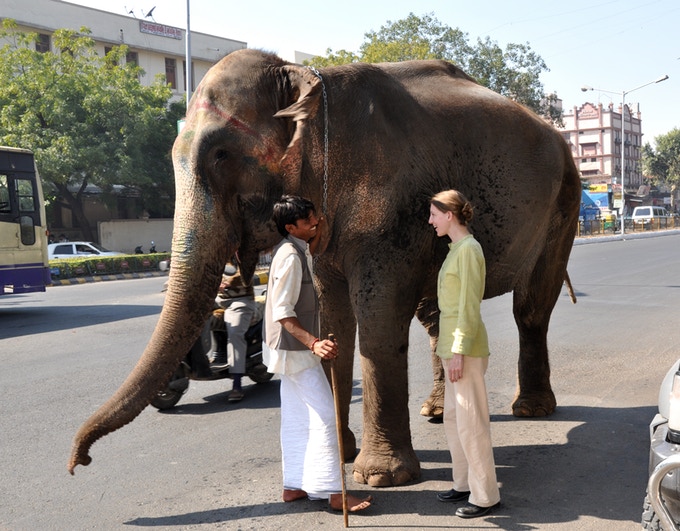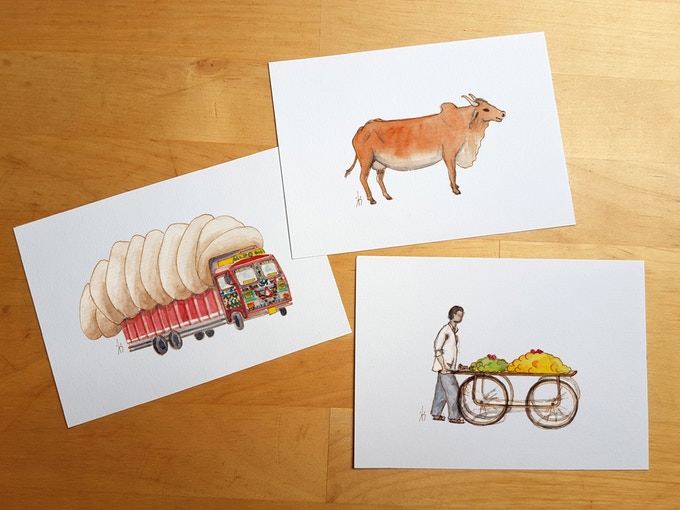Roads in India – vehicles, people & animals share the same space
Overcrowded roads with not just vehicles but also animals and pedestrians are not a rare sight in India. Painting a picture of the roads in India, artist Sara Keller comes up with the ‘Indian Mobilities’ project, through an exhibition and a book to share her experiences with the Indian traffic and to highlight the traffic issues in Indian cities.
From its culture and traditions to the roads, diversity defines India. Students heading to school on a rickshaw, friends ‘tripling’ (three people on one bike) on a bike, cyclists and joggers, vehicles, animals, street sellers, pedestrians and beggars moving together on the same road, is an everyday affair in the country.
“I lived for more than 10 years in India for my research work. During that time, I was fascinated by the Indian traffic and the diversity of people and vehicles on the roads. It was a contrast to the roads in Europe where you mostly see only cars,” says Sara Keller, a researcher (doctor in Building Archaeology).
As a painter using watercolours and stained glass to express herself, Keller started painting a precise, yet witty observation of the roads in India. “The ‘Indian Mobilities’ project is the result of my exploration of the colourful and dynamic roads in India,” she says.
‘Indian Mobilities’ is an exhibition as well as a book project on the roads in India. It is a poetic collection of watercolours on mobility, diversity and living together.
“I used to drive in France but still, driving in India was initially a challenge. I had to understand how to drive through this bubbling traffic. But gradually, not only cars, but I also drove scooters and bikes in India. In the process, I felt that I must share my experiences with people about the Indian traffic,” Keller tells MIG.
Expressing her fascination with the diversity of users and vehicles on the Indian roads, Keller aims to look at the recent deep societal changes and at the vital traffic issues in the quickly developing Indian cities and mega cities through the ‘Indian Mobilities’ exhibition in the German city of Stuttgart from September 14-October 15, 2018, which will be accompanied by the release of her book ‘India, Small and Big vehicles’.
The book is printed in French and German with the support of the French city of Strasbourg, and is a fun approach towards traffic in India. It is like a guide for those who want to learn driving in India. There are two parts: one describes all the vehicles and users of the road, and the other part has tips/advises about how to drive, with a lot of watercolour illustrations and text that Keller prepared.
“I think there are less signages and it looks like there are lesser rules. Still, the traffic goes smooth – there are no sudden breaks or rash accelerations like I was taught to do in France. Everything is smooth and in this process, vehicles, people and animals – all can share the space on the roads,” she exclaims.
“I was invited to present an exhibition on this project by the city of Stuttgart because it celebrates this year as 50 years of their partnership with Mumbai. They have lots of events and are keen in strengthening their friendship with India, and Mumbai in particular,” she explains.
Sustainable mobility is one of the top most priority in Stuttgart, which is the capital of the ‘Model Region for Sustainable Mobility’.
Stuttgart plans to celebrate the Mumbai-Stuttgart partnership year with a series of cultural and sport events this year. This can also be an opportunity to discuss the issue of mobility in Mumbai and to see how big Indian cities can manage the challenges related to road usage, traffic fluidity and connectivity.
The exhibition will showcase some of the original illustrations from the book, in addition to a few more about the challenges of mobility in metro-cities in India, huge number of vehicles, pollution and safety, amongst others.













